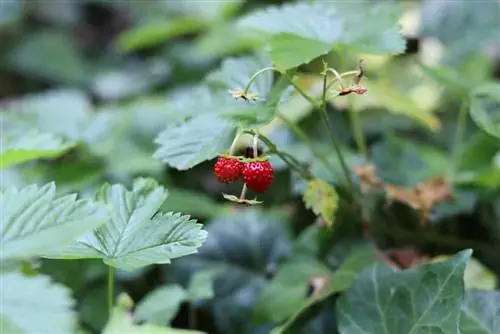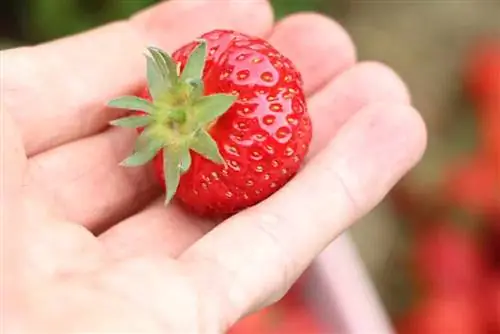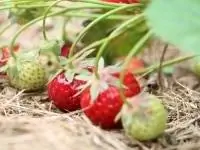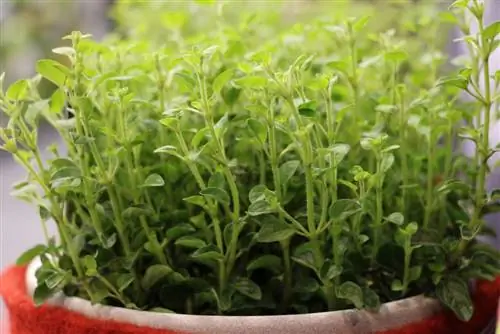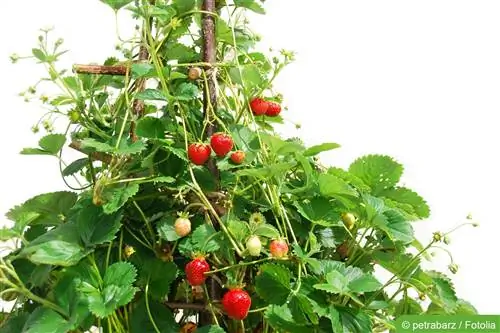- Author admin [email protected].
- Public 2023-12-17 03:39.
- Last modified 2025-06-01 06:48.
Monthly strawberries are something like a cross between wild strawberries and the classic garden strawberries. Botanically speaking, they come from wild strawberries. As a result, they also bear similarly small fruits. Their taste is significantly more intense than that of conventional garden strawberries. Above all, they are incredibly productive. Under normal circumstances, harvesting can take place between July and October of the year. The plants are also perennial and do not require much care. So it's no wonder that they are now incredibly popular among hobby gardeners.
Varieties
Monthly strawberries are available from specialist retailers either as seeds or as plants. There is now an enormous variety of varieties. What they all have in common is that they are relatively robust and productive. All varieties are basically just as suitable for growing in the garden as on the balcony. The most important and most widespread monthly strawberry varieties are:
- Merosa, which has an intense aroma of wild strawberries and is ideal for hanging baskets
- Hummi praline, whose fruits taste particularly intense and sweet
- Mara de Bois, which scores with slightly larger and very aromatic fruits and is ever-bearing
- Wädenswil, which produces very early ripe, fully aromatic fruits
- Ostara, which can grow between 30 and 40 centimeters high and is one of the few monthly strawberry varieties that forms runners
Tip:
Growing monthly strawberries with plants is much easier than with seeds. Young plants are available in spring for a few euros in garden centers or hardware stores.
Cultivation

So that monthly strawberries thrive and produce fruits that are as sweet and intensely fruity as possible, a sunny location is essential. It doesn't matter whether the strawberry plants are planted in a bed in the garden or in a planter on the balcony. In both cases it is also important to have very nutrient-rich soil. It should be well mixed with humus and have high permeability. Especially in the garden, the soil should ideally be mixed with compost and horn shavings. It is advisable to let the soil prepared in this way rest for about two weeks before planting the plants. The plants can go outdoors from around mid-May. A distance between the plants of 25 to 30 centimeters ensures that unhindered development and lush growth are possible. Experience has shown that close proximity to conventional garden strawberries should be avoided.
- sunny location
- nutrient-rich soil
- Loose the soil well
- 25 to 30 centimeters distance between the plants
If you would rather sow monthly strawberries instead of working with plants, you should only press the individual seeds lightly into the ground and cover them with a little soil or sand. The best month for this is April. Ideally, the seeds are used to grow plants indoors. To speed up germination, a small plastic bag should be placed over the planter, creating a greenhouse effect. The soil must be kept moist throughout. As soon as the small plants have three leaves, they should be repotted or pricked out. Of course, when you grow monthly strawberries yourself, they can normally be moved to the garden or balcony in the second half of May.
Care
Monthly strawberries are uncomplicated and very easy to care for plants. The effort involved with them is therefore kept within strict limits. If you give them a sunny location, that's practically half the battle. Of course, the water supply is still of central importance. Monthly strawberries love moist soil. Regular checks and regular watering are therefore very important. However, it is important to avoid waterlogging.
Tip:
In order to protect monthly strawberries that are grown in a planter from dangerous waterlogging, drainage with potsherds should be placed in the soil. This works reliably and can be done quickly and easily.
Since monthly strawberries continue to bear fruit over many months, they also need a lot of nutrients in order to be able to produce berries. The well-composted soil in which the plant was planted will sooner or later be depleted of nutrients. Then it is mandatory to compost again. Other types of fertilizer should generally be avoided and only compost should be used. This is distributed around the individual plants and carefully inserted into the soil. At least as important for a sufficient supply of nutrients to the strawberries is the regular removal of weeds.

This essentially takes away the nutrition from the monthly strawberries. At certain intervals you can't avoid weeding. In this context, it is also advisable to carefully loosen the soil every now and then to help the plants. And there's something else to keep in mind when caring for them: Even in May, it can still get bitterly cold in our latitudes, especially at night. Monthly strawberries do not tolerate cold or even frost any more than conventional garden strawberries. They must therefore be protected accordingly if necessary. A border made of straw or bark mulch is valuable here. Alternatively, covering it with a warming film at night can also be useful.
- compost regularly
- only use compost
- avoid other fertilizers at all costs
Harvest
The small, seductive fruits of the monthly strawberries are tempting to pick and snack on regularly. However, you should definitely make sure that the individual fruits are actually ripe. Only then do they develop their sweet, highly aromatic taste. Monthly strawberries generally do not ripen once they have been removed from the plant. The ripeness can be recognized by the fact that the entire fruit is intensely colored.
Tip:
Monthly strawberries taste particularly good and fruity when they are picked with a little style and sepals. Both should remain on the fruit after harvesting until it ends up in your mouth or on the cake.
Plants that were planted in May can usually be harvested for the first time in July. Depending on the variety you choose, the fruits will grow back regularly until October. As with other strawberries, the fruits of monthly strawberries are very sensitive to pressure. A certain degree of caution should therefore be exercised when harvesting. If you want to harvest a larger quantity, it is best to use a basket for collecting, in which the fruits must also be placed with great care. No reliable statement can be made about the yield that each individual plant delivers. Factors such as the variety or the weather simply play too big a role. In general, however, it can be said that monthly strawberries are considered extremely productive. There should be no shortage of berries.
After the season - wintering
- Cutting back leaves
- Use a knife, sickle or lawnmower
- compost thoroughly again
- keep in the same location
Even though monthly strawberries can be harvested over many months, at some point in the year the season is over for them. Once the last harvest has been harvested, we start preparing the plants for winter or the coming rest phase in October at the latest. The most important thing is to cut off the leaves. The process with these plants is very similar to that of standard garden strawberries. The best way to do this is to use a knife, secateurs, a sickle or maybe even a lawnmower. The cut leaves should definitely be destroyed and not composted.
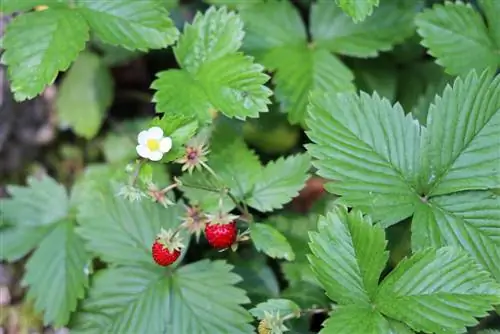
However, the soil should be thoroughly supplied with nutrients and thus compost before the rest period. This will make the restart next year much easier. Monthly strawberries can generally remain in the place where they were originally planted. Over the years, a veritable carpet of plants forms that covers the entire ground. Of course, over time the yield of fruit that can be obtained per plant also decreases. If you want to harvest roughly the same amount of berries every year, you can't avoid adding new plants regularly.
Tip:
If you leave some berries on the plants during the dormant phase, new sprouts can grow from the seeds they contain. Like the wild strawberry, the monthly strawberry also sows itself to a certain extent.
Propagation
Monthly strawberries generally do not form runners. The only exceptions here are special varieties such as Ostara or Sweetheart. If you are dealing with one of these varieties, the propagation of the plants is not a big problem. To do this, you simply carefully cut off the runner(s) and root them using the usual methods. Varieties without runners, however, cannot be propagated or can only be propagated with great difficulty. One possibility is to dry the seeds contained in the fruits and allow them to germinate from around April. However, success is not necessarily guaranteed with this method. Most of the time you can't avoid either buying new plants straight away or working with seeds from the bag.
What speaks for monthly strawberries
Monthly strawberries are the ideal plants for anyone who would like to harvest sweet fruits in their own garden without having to do too much work. What also works in favor of these little fruity things is that they can deliver an astonishingly high yield over several months. This makes up for the size disadvantage compared to conventional strawberries. In addition, the fruits of the monthly strawberries taste much more intense in comparison. And there is another very decisive advantage: monthly strawberries are extremely robust and hardly susceptible to disease. However, they are not immune to pests either. You should also know that birds in particular enjoy the ripe fruits. Appropriate protection, such as a net or other cover, can provide a reliable remedy here. Incidentally, monthly strawberries also score points for their wide variety of varieties. There are countless flavor variations here. If you love variety, you would do well to plant different varieties and then let yourself be surprised as you enjoy them. Monthly strawberries are just a joy in this respect too.

